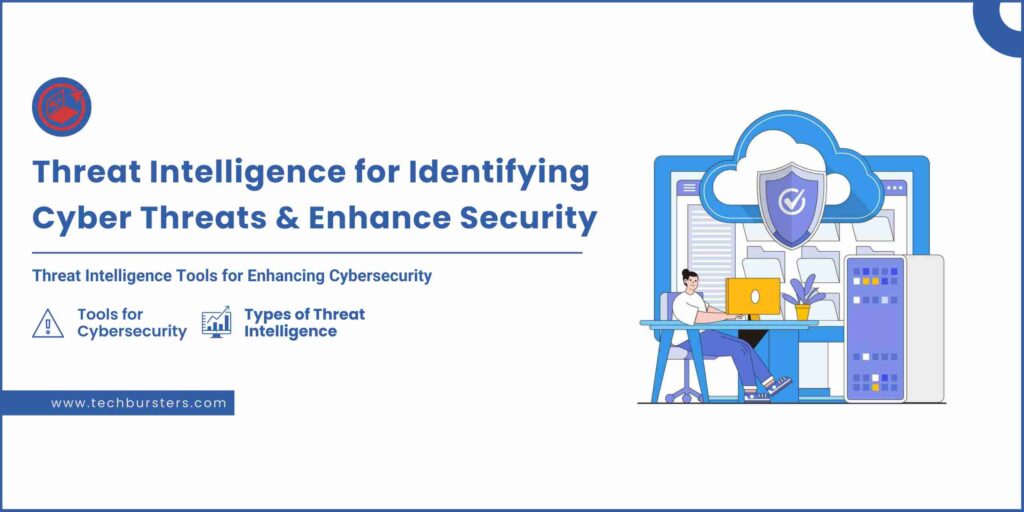
Every passing day, the webscape and the malware environments are changing in the air; becoming highly sophisticated, more frequent, and more catastrophic. Organizations of all sizes and in every industry and threat environment now face increasing risk of the breach of their data, their systems, and their business. Arguably, this strengthens the importance of robust cyber-security measures for organizations wishing to protect their property, reputations, and customer base. Threat intelligence is one of the most vital components of contemporary cyber security. This strategy is critical for successfully detecting, analyzing, and remediating threats in cyberspace.
What is Threat Intelligence?
Threat intelligence is the process of gathering, analyzing, and sharing information about current and potential cyber threats. This could be TTP (tactics, techniques, and procedures) of cybercriminals, vulnerabilities, malware, phishing campaigns, etc. The organization provides its security professionals with the data they need to recognize evolving threats, understand the behavioral aspect of threats, and develop strategies to prevent or respond to potential threats before they do any damage.
In contrast to these threats, traditional security measures are reactive, threat intelligence is proactive. It enables enterprises to detect and mitigate risks before they turn into major security incidents, he said. Threat intelligence can also be tailored to the needs of individual organizations, allowing businesses to recognize threats that are most likely to impact their operations.
What is Threat Intelligence and Why it Matters?
In cybersecurity, threat intelligence is very important, and that can save a lot of time and effort. This is vital to enabling organizations to be prepared to respond to the increasingly complex cyber threat landscape. There are key aspects that make threat intelligence extremely essential to detect cyber risks and enhance security plans:
- Predictive Threat Detection: Threat intelligence can be a great source of knowledge of potential vulnerabilities and exploits. Monitoring the global threat landscape helps organizations identify emerging cyber threats and enforce preventative measures before adversaries take advantage of vulnerabilities.
- Enhanced Decision-Making: Organizations can enhance their decision-making by having access to up-to-date and accurate threat data, which allows them to make better choices about prioritizing responses and allocating resources accordingly. This means they can do it fast and effectively.
- Improved Incident Response: In case of a security breach, threat intelligence enables security teams to discern the nature of the attack, its source , and the techniques used by the attackers. Having this knowledge can help expedite incident response, limiting harm.
- Threat Hunting and Forensics: Threat intelligence improves the detection of incoming malware before an attack can cause damage. It also helps in forensic investigations, giving a more accurate picture of how an attack developed.
- Alerts and Automation based on customization: The threat intelligence platform can be integrated with other security tools like SIEM (Security Information and Event Management) systems for automated alerts based on specific threat indicators. This helps ensure that suspicious activity is routed quickly to security teams.
- Regulatory Compliance – A wide range of industries face regulatory compliance requirements related to cybersecurity. Organizations that are using threat intelligence in their security approach will find that they are more aligned with industry guidelines and standards and are therefore able to show that they are committed to protecting your sensitive information.
Types of Threat Intelligence
- Reading time: 2–3 minutes intelligence can be classified into a variety of types, according to the level of detail and the scope of the information provided. These categories include:
- Strategic Threat Intelligence: This is high-level intelligence that centers around broader trends and patterns in the cyber threat landscape. This enables executives and decision-makers to assess the strategic implications of cyber threats to business goals and to make plans for sustained investments in cyber security.
- Tactical Threat Intelligence: This is more detail about specific threats, including information related to attack strategies, malware, and vulnerabilities. Doing so can enable security professionals to spot current threats quickly and act to mitigate them.
- Operational Threat Intelligence: Operational threat intelligence offers real-time data related to ongoing or impending cyberattacks. It usually provides information about the tactics, techniques, and procedures (TTPs) employed by attackers so organizations can take action quickly.
- Technical Threat Intelligence: This intelligence is very informative in nature with a specific focus on indicators of compromise (IOCs) such as IP addresses, domain names, and file hashes. It allows automated security systems to identify and stop previously known threats.
Good to Read:- Future-Proof Your OT Cybersecurity Strategy From Emerging Threats
The Role of Threat Intelligence Tools
To effectively harness threat intelligence, businesses need specialized tools and platforms that aggregate, analyze, and deliver actionable intelligence. These top threat intelligence tools can help organizations stay ahead of cyber adversaries by providing them with comprehensive and timely information. Here are some ways in which these tools contribute to security strategies:
- Gathering: Threat intelligence platforms collect data from multiple sources, such as open-source intelligence, dark web surveillance, internal security logs, and commercial threat feeds. It aggregates this information into a centralized repository for better access and analysis for security teams.
Early detection can slow down the threat of an attack, giving the system more time to run to safety and minimize loss of data. This act of looking for emerging threats, discovering new attack vectors, and constructing actionable insights without manual intervention.
- Seamless Integration with Security Framework: Threat intelligence solutions can seamlessly integrate with other security tools such as firewalls, intrusion detection systems (IDS), and SIEM tools. This enables a centralized security posture and guarantees threat intelligence is utilized to strengthen current defenses.
- Collaborative and shared: Many threat intelligence platforms promote inter-organizational collaboration, sharing insights about particular threat actors or attack vectors. Such collaboration is what builds the collective security posture of the wider community, which ultimately makes it harder for cybercriminals to succeed.
- Real-Time Alerts: These tools create real-time alerts upon detecting a possible threat, helping security teams respond quickly. Various threat indicators can offer alerts, such as anomalous network traffic and Indicators of Compromise (IoCs).
Top Threat Intelligence Tools for Enhancing Cybersecurity
There are many threat intelligence tools that organizations are widely using that give them the power to improve their capabilities and find emerging threats in their systems. Below are some of the best threat intelligence tools businesses can use today to enhance their security implementation:
- IBM X-Force Exchange: IBM X-Force Exchange is a cloud-based threat intelligence platform with valuable insights into the most recent threats to be actionable. It pulls in data from IBM’s massive threat research and links with security deployments to allow organizations to detect and respond to cyber threats in real time.
- CrowStrike Falcon Intelligence: CrowdStrike Falcon Intelligence provides a broad suite of threat intelligence services including real-time monitoring, TTP analysis, and integration with Falcon’s endpoint protection platform. It has detailed intelligence that can identify and neutralize threats.
- Most important for you FireEye iSIGHT: Advanced cyber threats, that detect and destroy vụ việc. It provides access to a worldwide threat database and real-time notifications to assist security teams in detecting and reacting to attacks.
- ThreatConnect: ThreatConnect is a collaborative threat intelligence platform designed for security teams to gather and analyze threat data and share it across various ecosystems. It also provides advanced analytics and threat intelligence feeds along with automation capabilities to effectively respond to security incidents and detect threats.
- Anomali Threat Platform: Anomali, which works closely with organizations to produce intelligence that can be turned into action, offers a more comprehensive solution for data collection, analysis, and integration. Its platform enables organizations to detect emerging threats and improve their security posture.
- Recorded Future: Recorded Future employs high-level machine learning and AI to determine real-time threat intelligence. It aggregates data from multiple sources and provides actionable insights that enable organizations to recognize threats and act accordingly.
- ThreatQuotient: ThreatQuotient provides a threat intelligence platform that enables organizations to automate the processing and sharing of threat intelligence. It works with security tools to increase incident detection and response times.
- MISP (Malware Information Sharing Platform): MISP is an open-source threat intelligence platform, used to share structured threat information among each other, in an organization. It is utilized for gathering, sharing, and collaborating on information regarding cyber threats, vulnerabilities, and malware.
Good to Read:- List of Top 10 AI Tools to Boost Cybersecurity
Why Threat Intelligence is Important in Improving Security Strategies
There are many advantages to integrating threat intelligence into an organization’s security strategy:
- Improved Prevention: Threat intelligence assists in identifying the existence of vulnerabilities before they can be exploited, which gives businesses time to install patches to affected systems and implement stronger defenses.
- Quick Reaction: The security team can react quickly to an attack to minimize its impact as it provides them with real-time alerts and also actionable intelligence.
- Refining Risk Assessment: By understanding which types of threats are most likely to attack the organization — whether they come from the outside or in-house — businesses can focus their security and correctly assign resources.
Fewer False Positives: Threat intelligence tools are good at weeding out noise, so they can cut down on the alerts that security teams need to investigate.
- Broad Coverage: The use of multiple sources of threat intelligence provides an expansive view of the threat landscape allowing organizations to defend against a range of cyberattacks.
Conclusion
The increased sophistication and frequency of such attacks in recent years have demonstrated the critical importance of threat intelligence in identifying potential risks and improving security strategies. Organizations that either proactively analyze threat data or even use the kind of source you won’t see are always one step ahead of the cybercriminal, notifying the customers causes the chances of a breach to become very minimal until they are patched. With the ever-changing landscape of the cyber threat environment, organizations can no longer afford to rely on traditional security measures and should look to implement some of the best threat intelligence platforms available today to enhance their ability to detect, respond to, and mitigate risks. As the threat landscape continues to evolve, Threat intelligence will continue to be a fundamental component of effective cybersecurity.
